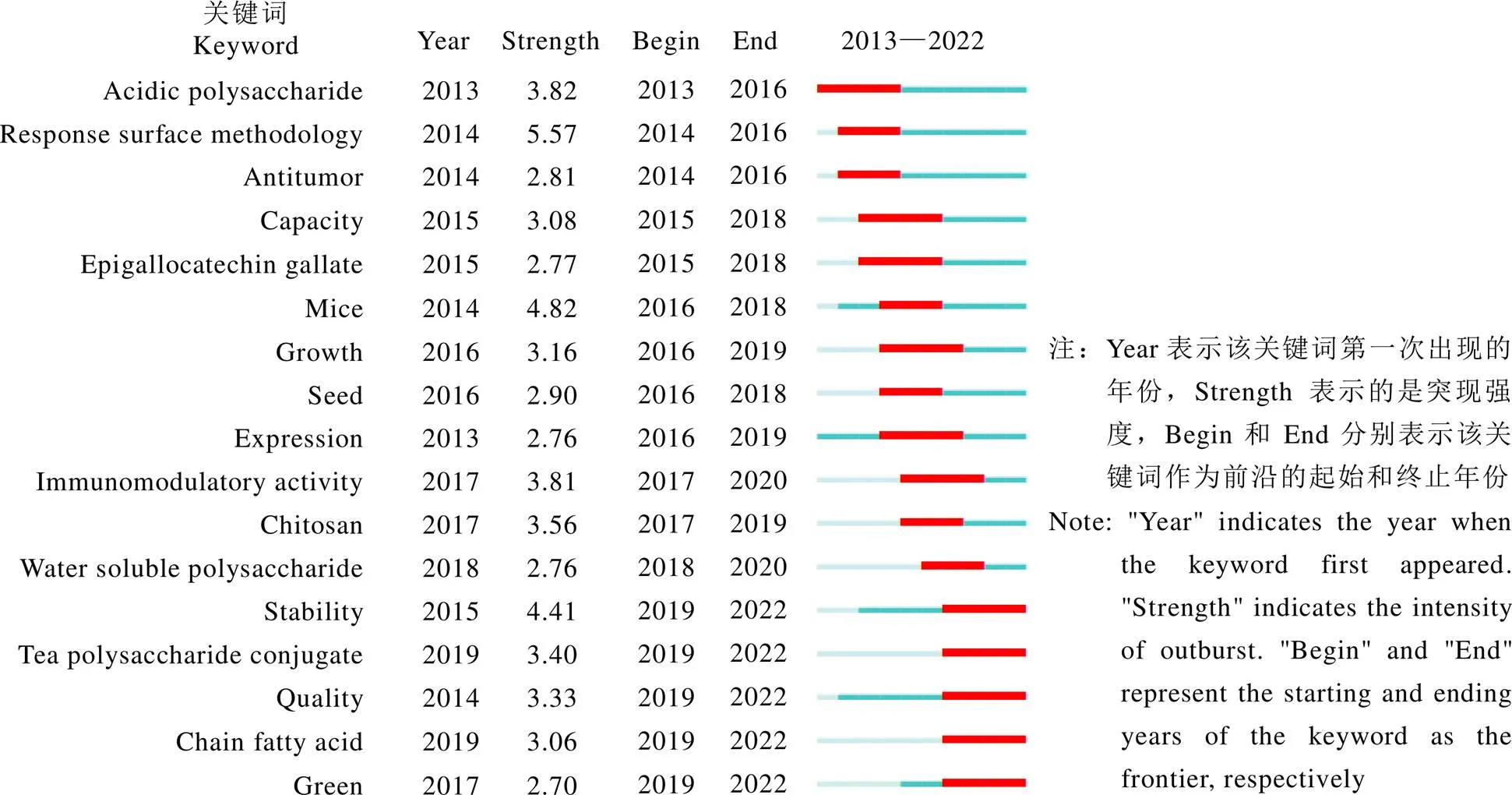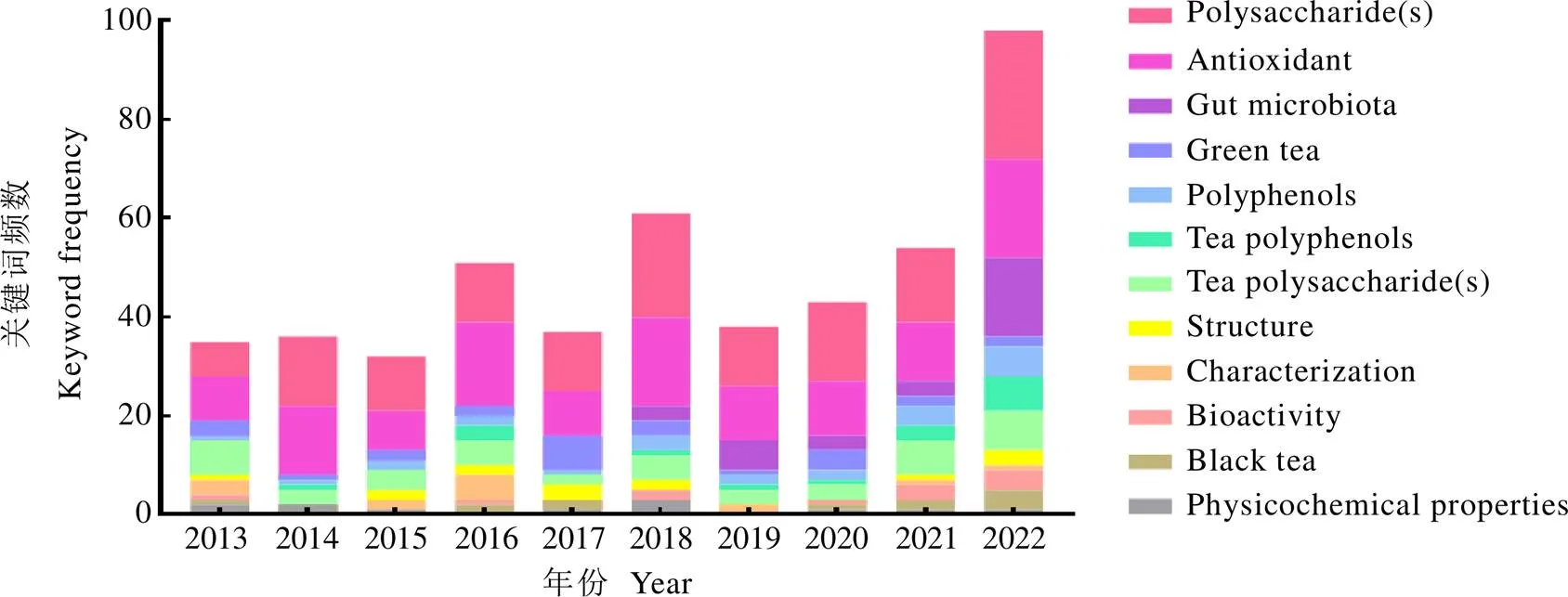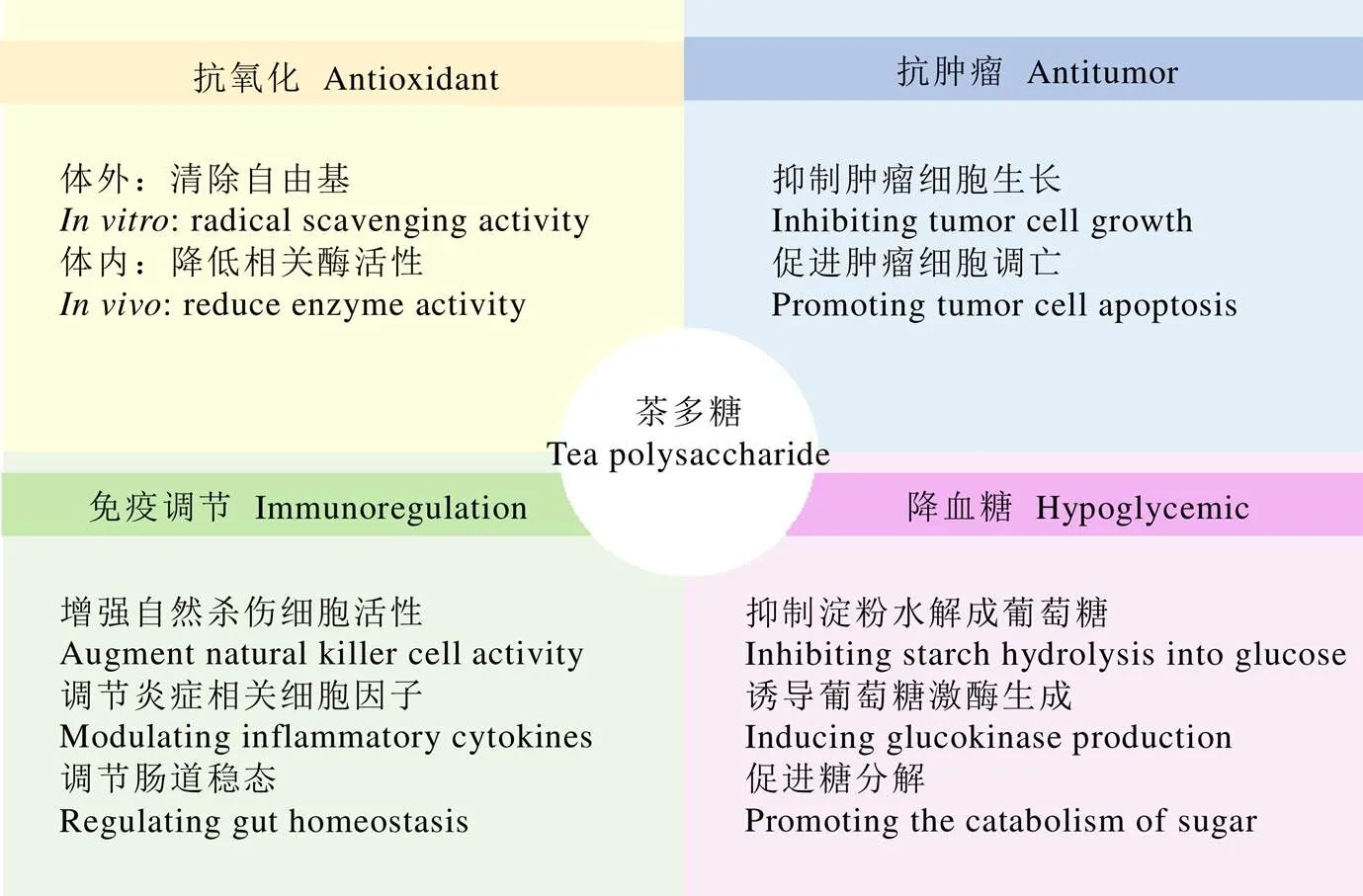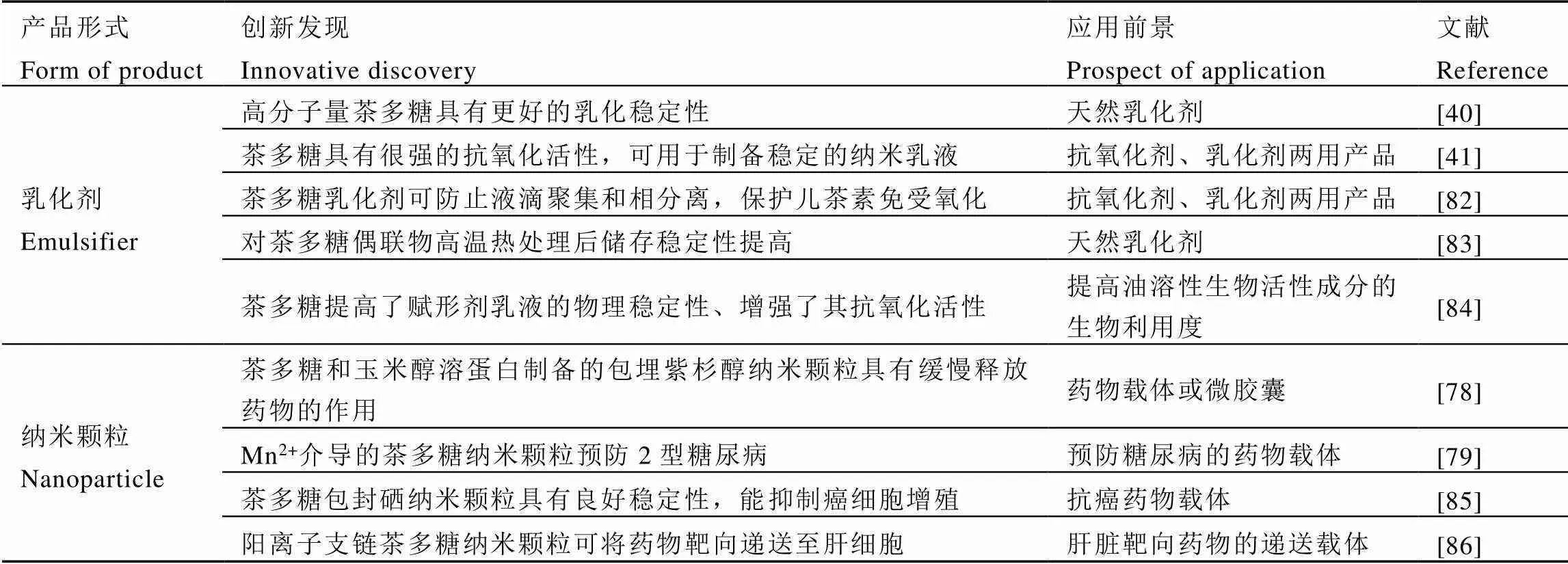茶多糖研究的现状与发展趋势
李焱,林泳峰,刘文美,邹泽华,刘光明,刘庆梅*
茶多糖研究的现状与发展趋势
李焱1,林泳峰1,刘文美2,3,4,邹泽华2,3,4,刘光明1,刘庆梅1*
1. 集美大学海洋食品与生物工程学院,福建省海洋功能食品工程技术研究中心,福建 厦门 361021;2. 厦门和美科盛生物技术有限公司,福建 厦门 361026;3. 三明市明八味产业研究院,福建 三明 353000;4. 长汀县绿色经济生态健康产业研究院,福建 龙岩 366300
茶多糖是茶叶中的重要活性成分,研究茶多糖的性质、推动茶多糖产品的开发将有利于茶产业及健康产业的发展。对Web of Science数据库中近十年茶多糖相关文献进行了可视化分析。结果显示,2013—2022年,茶多糖相关主题发文量总体呈增长趋势;关键词的共现、突现、频次分析结果均表明茶多糖的抗氧化性是持续的研究热点,这也可能是未来研究的主要趋势之一。当前,全球范围内茶多糖的研究主要集中在单糖组成、溶解性、乳化性等理化性质和抗氧化、抗肿瘤、抗糖尿病等生物活性方面。茶多糖虽具有多种生物活性,但相关的机理解析仍不够深入;最新研究表明茶多糖能够影响肠道菌群,具有良好的益生元潜力。另外,茶多糖相关产品的转化和开发尤为不足,研究者们未来可聚焦于利用茶多糖开发生物膜制品、药物递送产品及功能性食品等。总结茶多糖领域研究的主要内容和热点方向,旨在为该领域的研究者及茶多糖产业的发展提供参考。
茶多糖;可视化分析;抗氧化;肠道菌群
茶叶源自中国,目前已传播至160多个国家,是全球消费最广泛的植物性饮料[1]。茶叶主要分为绿茶、红茶、黄茶、白茶、乌龙茶和黑茶六大类[2]。茶叶中的生物活性成分主要有茶多酚和茶多糖等[3],茶多糖主要来源于茶叶、茶花和茶叶籽[4];与茶多酚相比,茶多糖更为稳定,关于其性质、活性、结构的研究正处于初步探索阶段。目前,研究者们通常采用热水提取、酶法处理或超声辅助提取茶多糖,并发现茶多糖具有抗氧化、抗肿瘤、免疫调节、抗糖尿病等生物活性[4],有望将其应用于功能性食品及医药制剂[5]。
统计分析文献数据,能够捕捉对应研究领域的研究动态,通过分析最近一段时间内的研究热点,还能预测该领域的研究趋势[6-7]。随着茶产业的发展,关于茶多糖的研究内容也逐渐丰富,但目前尚缺乏对其进行统计分析的科学文献数据,关于茶多糖研究现状与发展趋势的系统总结尚不完善。因此,本文对Web of Science(WOS)数据库中关于茶多糖研究的文献进行了可视化分析,并基于分析结果解析了茶多糖研究的现状和发展趋势,旨在阐明茶多糖的研究热点,预测其发展方向,为深入研究茶多糖的生物活性及产品开发提供理论指导,为相关领域的研究者们提供参考。
1 茶多糖研究可视化分析
可视化分析结果能够显示某一研究的总体发展趋势,揭示相关研究领域的热度时期以及学者们的重视程度[8-9]。2013—2022年WOS数据库中以茶多糖为主题的文献共计827篇,年发文量总体呈稳步增长趋势,近5年的发文量占据整体区间的68.32%;由此可见,近年来茶多糖研究已受到越来越多研究者的重视。
1.1 Citespace可视化分析
Citespace知识可视化软件是华裔学者陈超美开发的知识图谱绘制工具[10],其分析图谱能够直观展现科学知识领域的信息全景,探索该领域的关键文献、热点研究和前沿方向[7,11]。以Web of Science为检索平台,查找主题词为“tea polysaccharide”的文章。对WOS数据库中2013年1月1日—2022年12月31日发表的核心文献进行专业检索,勾选论文、综述选项,设置语种为英语,共筛选出827篇文献(2023年1月2日检索)。在JAVA运行环境下[10],使用Citespace软件6.1.R6版本对筛选的827篇文献的Keywords进行共现分析、聚类分析和突显分析。
关键词是对文献核心内容的提炼和概括,代表文章的主题。对以“tea polysaccharide”为主题词所筛选文献的关键词进行可视化分析,可以解释WOS数据库中2013—2022年茶多糖的研究现状与发展趋势。图1为WOS数据库中茶多糖研究的关键词共现图谱,每个节点代表1个关键词,节点的大小代表关键词出现的频次,关键词间的连线表示两者出现在同一篇文章中;线条的粗细代表关键词之间关系的重要程度[12]。由图1可知,除主题词“tea polysaccharide”之外,茶多糖研究领域高频且重要的关键词有antioxidant activity、green tea和in vitro等,即抗氧化活性、绿茶多糖、体外研究是近十年来茶多糖研究的主要关注点。关键词共现图谱中有出现polyphenol(茶多酚),表示在茶多糖相关的研究中通常会涉及茶多酚[13-14]。
关键词突现指的是某一关键词在短时间内的使用频次显著增加,关键词突现分析可揭示某一研究领域快速增长的热点,预测对应学科研究的新兴趋势[15]。利用Citespace软件获得2013—2022年间茶多糖研究的突现关键词如图2所示。由图2可知,不同年份研究者所关注的研究热点不同。第一阶段为2013—2018年,茶多糖研究突现的关键词主要有acidic polysaccharide(酸性多糖)、response surface methodology(响应面法)、epigallocatechin gallate(没食子酸),说明这一阶段茶多糖的研究热点主要为提取茶多糖、分析茶多糖的物理性质。第二阶段为2017—2020年,突现的关键词主要有immunomodulatory activity(免疫调节活性)、water soluble polysaccharide(水溶性多糖),说明这一阶段茶多糖的研究热点主要为茶多糖的免疫调节活性及理化性质。第三阶段为2019—2022年,突现的关键词主要有tea polysaccharide conjugate(茶多糖偶联物)和chain fatty acid(链式脂肪酸),说明这一阶段茶多糖的研究热点主要为茶多糖偶联物及其与肠道菌群的关系。由于茶多糖的生物活性与其结构特性密切相关[16],所以在这3个阶段中虽然研究热点不同,但均呈现理化性质与生物活性共同发展的特点。

图1 WOS数据库中茶多糖的关键词共现图谱
1.2 茶多糖关键词频数分析
研究热点指某研究领域中被关注的焦点,可代表某一阶段中该研究领域所聚焦的主要问题;关键词的出现频次可揭示科学研究的热点及趋势[17]。利用文献计量分析平台(https://bibliometric.com)对827篇文献的主要关键词在每年出现的次数进行累加,得到WOS数据库中茶多糖研究的主要关键词年度分布(图3)。由图3可知,关键词频数呈现逐年上升趋势。其中,polysaccharide(多糖)与tea polysaccharide(茶多糖)的出现频次总体上呈稳定上升趋势。由于茶多糖相关文献的年度发文量与年度关键词频数都呈现逐年上升的趋势,因此,可以初步预测未来与茶多糖相关的研究可能会越来越多。antioxidant(抗氧化性)的出现频次虽有所波动,但其每年出现频次均位居第二,说明在世界范围内茶多糖的研究热点主要聚焦于抗氧化性。在被分析的827篇文献中,用细胞试验对茶多糖抗氧化活性验证的研究还较少,考虑到茶多糖的生物安全性,用细胞试验验证其抗氧化性可能会成为新的趋势。chain fatty acid是2019—2022年间的突现关键词(图2),关键词gut microbiota的出现频数在2019年和2022年明显上升(图3),说明茶多糖对肠道菌群的影响在2019—2022年成为了新的研究热点。茶多糖虽然不能被机体消化吸收,但其能作为肠道菌群的碳源可以通过影响菌群比例和丰度发挥益生元作用[18]。例如,Li等[19]研究发现,茶多糖通过调节肠道菌群、改善宿主代谢,发挥降血糖和降血脂的作用。红茶水提物能够通过调节肠道微生物群和宿主组织中的基因表达来减少饮食诱导的小鼠肥胖[20]。由此可见,茶多糖可通过影响肠道菌群发挥改善疾病的作用。

图2 WOS数据库中茶多糖研究的关键词突现分析

图3 WOS数据库中茶多糖研究主要关键词年度分布
2 茶多糖的研究现状
学者们对茶多糖的研究主要集中于理化性质解析及生物活性探索方面。WOS数据库中,发表茶多糖相关文章的期刊学科类别主要为食品科学及科技(Food Science & Technology,341篇)、化学应用(Chemistry Applied,234篇)、生物化学和分子生物学(Biochemistry & Molecular Biology,213篇),说明茶多糖的主要发展方向为食品科学、化学和生物学,主要涉及茶多糖的抗氧化性[21-23]、茶多糖对肠道菌群的影响[18,24-26]和茶多糖的结构特性[27-28]研究。
2.1 茶多糖的理化性质
茶多糖的理化性质包括单糖组成、糖醛酸和蛋白质的含量、平均分子量、溶解度、粘度、乳化性及茶多糖的结构[29-30]。研究表明,茶多糖通常由半乳糖、阿拉伯糖、鼠李糖等2~10个单糖经糖苷键连接而成[30],不同原料或不同制备方法得到的茶多糖具有不同的单糖组成。糖醛酸是糖中伯羟基被氧化成羧基后形成的化合物及其衍生物,在茶多糖中比其他组分更稳定[31],含有糖醛酸的茶多糖组分可能具有更高的生物活性[4]。研究发现,茶多糖在反复脱蛋白后仍然含有少量蛋白质,说明大多数茶多糖是与蛋白质结合的多糖偶联物[4]。值得注意的是,随着发酵及储存时间的延长,茶多糖的糖醛酸及蛋白质含量可能会升高[32],从不同发酵程度茶叶中提取的茶多糖在生物活性上也有差异[33]。平均分子量是判断多糖化学性质的重要指标,由于茶多糖的原料较为丰富,所以不同来源的茶多糖的分子量分布范围较广。分子量小的多糖可能具有更低的粘度,因此更容易进入细胞[30],其生物活性也就越高[34-35]。但分子量太小的多糖可能无法形成活性结构,例如,Wang等[36]研究发现,茶叶籽多糖的分子量较小,与分子量较大的茶叶多糖和茶花多糖相比,其抗氧化作用更弱。茶多糖含有较多极性基团[37],因此具有很强的亲水性,其亲水性与分子量有关,分子量小的茶多糖溶解度更高[30]。适当加热会促进茶多糖的溶解,这也是大多数研究选择用热水提取茶多糖的原因。多糖分子在溶液中以无规卷曲的形式存在[38],所以多糖在水溶液中具有高粘度,甚至形成凝胶。目前的研究发现,茶多糖的分子量与其粘度呈正相关[39]。乳化剂是生产食品、药品、化妆品的重要原料,从天然植物中提取的多糖作为乳化剂或许会有更高的生物安全性。近年来,研究者们陆续开始探索茶多糖的乳化特性。Chen等[40]研究发现,不同分子量的绿茶多糖在乳化性能上具有差异。Li等[41]从青砖茶中获得了具有良好乳化性能和抗氧化活性的茶多糖缀合物。茶多糖的化学结构包括糖苷键的类型及位置、单糖序列、分子链构象等[4,29-30]。研究表明,不同的糖苷键还可能会影响茶多糖的生物活性[42],具有1→3糖苷键和1→6糖苷键的茶多糖通常具有生物活性[43-45]。但总的来说,由于茶多糖是一种复杂的大分子杂多糖,因此目前仍没有理想的方法阐述其结构与生物活性之间的关系。
2.2 茶多糖的生物活性
茶多糖具有抗氧化、抗癌、抗糖尿病、抗炎等生物活性。目前,已被报道的茶多糖约有120余种[44]。研究表明,青砖茶[46]、茯砖茶[47]、黄茶[48]等茶叶中的多糖均具有抗氧化活性[49-52]。多数研究通过茶多糖的1,1-二苯基-2-苦基肼(1,1-diphenyl-2-bitterhydrazine,DPPH)自由基、超氧阴离子自由基、羟基自由基清除活性等化学反应来验证茶多糖的抗氧化性。近年来,逐渐有研究者利用体外细胞模型或小鼠模型来验证茶多糖的抗氧化作用。例如,Fan等[53]通过构建人脐静脉内皮细胞模型验证了茶多糖的抗氧化活性。另外,研究者们通过细胞模型和动物模型验证了茶多糖对乳腺癌、胃癌、肝癌、结肠癌等的抑制作用[4]。Liu等[54]研究表明,绿茶多糖可通过抑制小鼠结肠癌细胞的增殖和侵袭发挥抗癌潜力。Wang等[55]研究发现,紫阳绿茶中的富硒茶多糖能够在体内外抑制人骨肉瘤U-2 OS细胞增殖,发挥抗癌作用。由成熟茶叶制成的茶饮在中国和日本民间被用来治疗糖尿病[31],Wang等[56]的研究表明,五峰绿茶中发挥治疗糖尿病效果的关键成分是茶多糖。目前报道具有抗糖尿病活性的茶多糖主要来源于绿茶,茶多糖抗糖尿病活性可能是通过调控cAMP-PKA或PI3K/Akt信号通路实现的[56-57]。Chung等[58]研究认为,茶多糖具有降血糖作用,其作用机理可能通过抑制淀粉水解成葡萄糖,延缓葡萄糖的吸收和运输,从而降低血糖。此外,研究者们还发现茶多糖具有抗炎活性和免疫调节活性。例如,Zhao等[59]发现,富硒茶多糖通过增强肠道屏障、调节肠道菌群改善了小鼠的溃疡性结肠炎。Kim等[60]从绿茶中提取了儿茶素、黄酮醇及粗多糖,发现三者的联合治疗能减弱气道上皮细胞中粉尘颗粒诱导的炎症基因表达。茶多糖可通过降低促炎细胞因子水平,增加抗炎细胞因子水平的方式改善小鼠结肠炎[61]。Cheng等[62]通过昆明小鼠的S-180癌症异种移植模型验证了富硒茶多糖的免疫调节活性。同时,茶多糖的结构与其生物活性之间具有密不可分的关系[44],Chen等[27]研究发现,超高压处理后的茶多糖的初级和空间结构均被改变,其糖醛酸含量和生物活性提高。也有研究者称,活性多糖的结构直接决定其生物活性[63];杨玉洁等[64]对具有降血糖活性的多糖进行了系统总结,发现多糖的降血糖活性与其分子量、单糖组成、糖苷键、高级结构及多糖基团相关。目前的研究虽发现茶多糖具有多种生物活性,但尚缺乏对其构效关系的解析,部分文献虽同时探索了茶多糖的理化性质及生物活性,但并未研究其相互作用关系。因此,研究者们在解析茶多糖的结构和生物活性时也应重点关注其构效关系。
3 茶多糖研究的发展趋势
随着相关研究的深入,茶多糖具有多种生物活性的优势逐渐凸显,但目前的研究仍处于对其生物活性的初步探究阶段,尚未对相关机理进行深入解析。同时,与茶多糖生物活性相关的产品转化也相对较少。因此,为促进茶多糖的开发利用,研究者们未来需要深入探究茶多糖对应生物活性的作用机理、开发与之生物活性对应的健康产品。
3.1 茶多糖生物活性的机理解析
本文总结了茶多糖发挥生物活性的相关机理,如图4所示。现有的研究虽表明茶多糖具有多种生物活性,但对其发挥生物活性的作用机理的探究尚有不足。尽管许多研究者们发现了茶多糖具有抗氧化活性,但大多数研究都仅通过体外化学反应进行验证,目前还缺乏解析茶多糖在动物体内抗氧化机制的研究。利用小鼠模型验证茶多糖抗氧化性的研究通常仅测定了小鼠肝/肾和血液中超氧化物歧化酶、谷胱甘肽过氧化物酶等生化参数值[65-66],而未对茶多糖在小鼠体内发挥抗氧化活性的途径进行解析。
相比之下,研究茶多糖发挥降血糖、抗癌、免疫调节作用的文献已开始探索相关作用机理。除了前文提到的抑制淀粉水解成葡萄糖外,茶多糖发挥抗糖尿病活性的另一可能途径是通过在体内清除自由基,减弱自由基对胰岛细胞的损伤,使胰岛素分泌增加,提高胰岛素敏感性,诱导葡萄糖激酶的生成,促进糖分解以降低血糖[67]。此外,Xu等[31]研究表明,茶多糖偶联物的潜在抗肿瘤机制主要为直接抑制肿瘤细胞生长,促进肿瘤细胞凋亡,或通过改善免疫系统促进癌细胞的早期凋亡,但与上述机制相关的信号通路还有待探索。免疫调节作用是天然植物多糖的重要活性之一,已有研究表明,茶多糖可通过增加toll样受体7的吞噬活性[68]、增加自然杀伤细胞活性[69]、调节炎症相关细胞因子[70]等方式发挥免疫调节作用。
肠道是机体最大的免疫器官,茶多糖的免疫调节作用主要通过影响肠道免疫来实现,这是因为茶多糖不会被口腔及胃肠道内的酶所消化,而是在进入大肠后作为碳源被肠道菌群利用[24];菌群代谢产生的短链脂肪酸、吲哚衍生物、多胺等物质经肠道吸收后能参与调节机体的生理功能,发挥抗炎、免疫调节等作用[71]。正因如此,大多数利用动物模型探究茶多糖抗炎活性的研究都与结肠炎[59]或由结肠炎诱导的癌变[54,61]有关。此外,Chen等[72]利用体外结肠发酵模型也证明了肠道菌群可通过利用茯砖茶多糖产生短链脂肪酸等有利代谢产物改变发酵体系pH,进而改善炎症性肠病患者的肠道菌群比例和丰度。综上所述,茶多糖通过调节肠道菌群的代谢影响肠道稳态可能是其发挥各种生物活性的重要途径[31]。因此,研究者们在对茶多糖改善机体疾病的研究中可重点关注茶多糖对肠道稳态的调节。
3.2 茶多糖相关产品的应用
已有研究证明,动植物多糖及海藻多糖可作为食品保鲜薄膜改善果蔬、肉类、海产品等食物的贮藏品质[73]。与合成薄膜相比,多糖薄膜具有更好的气体阻隔性能,以及可食用和可生物降解等优点[74]。然而,多糖在薄膜中会表现出较差的阻水性能,因此,为了改善薄膜的耐水性和机械性能,研究者们通常会在多糖薄膜中掺入蛋白质[75],使薄膜成为偶联聚合物。在乳液体系里,偶联物中的蛋白质会吸附在油表面,而亲水部分则突出到水溶液中;当多糖链缓慢吸附到界面上后,蛋白质会被解开并暴露出疏水氨基酸,然后在油相中重新排列;至此,蛋白质和多糖分别分布于油水界面,使偶联物形成粘弹性膜[76]。而茶多糖是一种多糖与蛋白质的偶联物,兼具多糖及蛋白质作为食品保鲜膜的优点,以及多种生物活性,所以具有开发成食品保鲜膜及生物膜的潜力。同时,茶多糖具有良好的乳化性能[40-41],故有望应用于饮料、烘焙食品、肉制品和果酱生产中,以增加产品的粘度和稳定性,改善产品的质地,提高食品的质量[77]。
天然来源的多糖具有低毒性、可再生、生物相容性高等优点,可用作药物载体。Li等[78]利用茶多糖和玉米醇溶蛋白制备了包埋紫杉醇(一种抗癌药)的纳米颗粒,并通过体外试验发现这种纳米颗粒能起到缓慢释放药物的作用;Fan等[79]合成了一种负载Mn离子的茶多糖纳米颗粒,并发现这种纳米颗粒在小鼠体内具有比单独使用茶多糖更有效的降血糖作用;由此可见,茶多糖作为药物载体或微胶囊型药品应用于医药领域。一些具有抗炎、抗氧化、抗癌作用的植物多糖常被应用于护肤品中[80],以预防皮肤的老化或癌变,表明茶多糖还具有应用于化妆品的潜力。基于茶多糖能够调节肠道菌群,具有益生元特性,还可被用于开发为益生元产品,起到增强免疫力或改善疾病的作用。考虑到茶多糖的抗糖尿病特性,研究者们可将其开发为适宜糖尿病人食用的特殊医学用途食品。此外,茶多糖虽已被证实具有多种生物活性,但与之相关的临床产品及应用却较为罕见。可以参考的是,研究者们从黄芪、人参等植物中提取了具有抗癌活性的多糖,并以静脉注射液的形式将它们用于癌症患者的临床治疗[81]。

图4 茶多糖的生物活性及相关机理
Fig.4 Biological activity and related mechanism of tea polysaccharides
本文对茶多糖相关产品的转化研究进行了总结(表1)。总的来说,茶多糖具有优良的乳化特性及抗氧化、抗癌、降血糖等多种生物活性,在功能性食品及医药产品方面具有巨大应用潜力;为促进茶多糖及茶产业的发展,研究者们还应重点关注茶多糖在功能性食品、生物膜、医疗制剂等方向的产品转化。

表1 茶多糖的产品开发及应用前景
4 结论与展望
茶多糖是茶叶的重要成分及主要活性成分,解析茶多糖的理化性质、探究其生物活性,对开发茶多糖相关产品具有重大意义。促进茶多糖相关产品转化不仅能推动茶产业发展,也有利于全民大健康产业的发展。近十年来,WOS数据库中关于茶多糖研究的发文量逐年增多,本文对茶多糖相关研究进行了总结分析。总的来说,茶多糖的理化性质及生物活性为该领域的主要研究热点。在理化性质方面,大多数研究探索了茶多糖的单糖组成、平均分子量及糖醛酸含量。在生物活性方面,研究者们主要关注茶多糖的抗氧化活性,近年来逐渐开始探索其抗癌、抗炎、抗糖尿病等生物活性。2019—2022年关于茶多糖对肠道菌群影响的文章数量出现明显增长,这或将成为解析茶多糖如何发挥生物活性的新途径。
尽管现代研究已发现茶多糖具有抗氧化、抗癌、抗糖尿病等多种生物活性,但随着发文量的增多,与之相关的产品转化研究未见增长,关于其发挥生物活性的机理解析也不够深入。这是由于茶多糖的结构复杂、多糖的结构测定和性质分析等未形成体系,给多糖的产品转化和临床应用带来了很大的限制。随着技术的进步,茶多糖产业的发展将更加迅猛。为促进茶多糖的开发和利用,需要对茶多糖进行更为深入地研究,以便解析其构效关系及发挥生物活性的作用机制。由于茶多糖具有特殊的理化性质及生物活性,可考虑食品保鲜剂、生物膜制品、药物递送载体、益生元产品、特医食品、抗癌药物等相关产品的转化。
[1] 程利增, 朱将雄, 周慧, 等. 茶多糖提取纯化、结构活性及应用研究进展[J]. 中国茶叶, 2021, 43(8): 7-15. Cheng L Z, Zhu J X, Zhou H, et al. Research progress on the extraction, purification, structures, activities and application of tea polysaccharides [J]. China Tea, 2021, 43(8): 7-15.
[2] 翁昆, 张亚丽. GB/T 30766—2014《茶叶分类》简介[J]. 中国标准导报, 2015(1): 34-35. Weng K, Zhang Y L. Introduction to GB/T 30766-2014 "Classification of Tea" [J]. China Quality and Standards Review, 2015(1): 34-35.
[3] 欧阳建, 周方, 卢丹敏, 等. 茶多糖调控肥胖作用研究进展[J]. 茶叶科学, 2020, 40(5): 565-575. Ouyang J, Zhou F, Lu D M, et al. Research progress of tea polysaccharides in regulating obesity [J]. Journal of Tea Science, 2020, 40(5): 565-575.
[4] Chen G, Yuan Q, Saeeduddin M, et al. Recent advances in tea polysaccharides: extraction, purification, physicochemical characterization and bioactivities [J]. Carbohydrate Polymers, 2016, 153: 663-678.
[5] 翁蔚, 李书魁, 张琴梅, 等. 茶多糖的组成与保健功效研究进展[J]. 中华中医药杂志, 2021, 36(12): 7261-7264. Weng W, Li S K, Zhang Q M, et al. Research progress of composition and health function of tea polysaccharide [J]. China Journal of Traditional Chinese Medicine and Pharmacy, 2021, 36(12): 7261-7264.
[6] 李东旭, 陈富桥. 基于CiteSpace文献计量分析的中国茶产业经济研究现状与展望[J]. 华中农业大学学报, 2022, 41(5): 57-67. Li D X, Chen F Q. Situation and prospect of studies on tea industry in China based on CiteSpace bibliometnic analysis [J]. Journal of Huazhong Agricultural University, 2022, 41(5): 57-67.
[7] 张鑫, 王吉, 胡静荣, 等. 基于Citespace和文献计量分析平台的鱼糜研究可视化分析[J]. 食品科学, 2023, 44(1): 362-370. Zhang X, Wang J, Hu J R, et al. Visual analysis of surimi research based on Citespace and bibliometric analysis platform [J]. Food Science, 2023, 44(1): 362-370.
[8] Sun Y Q, Wu S M, Gong G Y. Trends of research on polycyclic aromatic hydrocarbons in food: a 20-year perspective from 1997 to 2017 [J]. Trends in Food Science & Technology, 2019, 83: 86-98.
[9] Chen S Y, Han R, Liu H T. A bibliometric and visualization analysis of intermittent fasting [J]. Frontiers in Public Health, 2022, 10: 946795. doi: 10.3389/fpubh.2022.946795.
[10] 陈悦, 陈超美, 刘则渊, 等. CiteSpace知识图谱的方法论功能[J]. 科学学研究, 2015, 33(2): 242-253. Chen Y, Chen C M, Liu Z Y, et al. The methodology function of CiteSpace mapping knowledge domains [J]. Studies in Science of Science, 2015, 33(2): 242-253.
[11] 周钰, 刘庆梅, 张军, 等. 基于Citespace对抗食物过敏研究领域的可视化分析[J]. 中国食品学报, 2021, 21(6): 366-374. Zhou Y, Liu Q M, Zhang J, et al. Visualization analysis of anti food allergy reasearch based on Citespace [J]. Journal of Chinese Institute of Food Science and Technology, 2021, 21(6): 366-374.
[12] 吴晓秋, 吕娜. 基于关键词共现频率的热点分析方法研究[J]. 情报理论与实践, 2012, 35(8): 115-119. Wu X Q, Lü N. Research on the hot spot analysis method based on keyword co occurrence frequency [J]. Information Studies: Theory & Application, 2012, 35(8): 115-119.
[13] Li X, Chen S, Li J E, et al. Chemical composition and antioxidant activities of polysaccharides fromtea [J]. Oxidative Medicine and Cellular Longevity, 2019, 2019: 1915967. doi: 10.1155/2019/1915967.
[14] Guo L, Guo J C, Zhu W C, et al. Optimized synchronous extraction process of tea polyphenols and polysaccharides from Huaguoshan Yunwu tea and their antioxidant activities [J]. Food and Bioproducts Processing, 2016, 100: 303-310.
[15] 穆军芳, 张丽鑫, 杨光. 基于WOS的国际农业生态学研究热点与前沿探究[J]. 中国生态农业学报(中英文), 2022: 1-12. [2023-05-09]. http://kns.cnki.net/kcms/detail/13.1432. S.20221228.1328.002.html. Mu J F, Zhang L X, Yang G, et al. A Study on the research hotspots and emerging trends of international agroecology based on WOS [J]. Chinese Journal of Eco-Agriculture, 2022: 1-12. [2023-05-09]. http://kns.cnki.net/kcms/detail/13. 1432.S.20221228.1328.002.html.
[16] Qu J L, Huang P, Zhang L, et al. Hepatoprotective effect of plant polysaccharides from natural resources: a review of the mechanisms and structure-activity relationship [J]. International Journal of Biological Macromolecules, 2020, 161: 24-34.
[17] Xu Y L, Wang Y J, He J L, et al. Antibacterial properties of lactoferrin: a bibliometric analysis from 2000 to early 2022 [J]. Frontiers in Microbiology, 2022, 13: 947102. doi: 10.3389/fmicb.2022.947102.
[18] Chen G J, Zeng Z Q, Xie M H, et al. Fermentation characteristics and probiotic activity of a purified fraction of polysaccharides from Fuzhuan brick tea [J]. Food Science and Human Wellness, 2022, 11(3): 727-737.
[19] Li H S, Fang Q Y, Nie Q X, et al. Hypoglycemic and hypolipidemic mechanism of tea polysaccharides on type 2 diabetic rats via gut microbiota and metabolism alteration [J]. Journal of Agricultural and Food Chemistry, 2020, 68(37): 10015-10028.
[20] Liu X L, Hu G S, Wang A H, et al. Black tea reduces diet-induced obesity in mice via modulation of gut microbiota and gene expression in host tissues [J]. Nutrients, 2022, 14(8): 1635. doi: 10.3390/nu14081635.
[21] Wang Y L, Zhao Y, Andrae-Marobela K, et al. Tea polysaccharides as food antioxidants: an old woman’s tale? [J]. Food Chemistry, 2013, 138(2/3): 1923-1927.
[22] Lu X S, Zhao Y, Sun Y F, et al. Characterisation of polysaccharides from green tea of Huangshan Maofeng with antioxidant and hepatoprotective effects [J]. Food Chemistry, 2013, 141(4): 3415-3423.
[23] Xu P, Wu J, Zhang Y, et al. Physicochemical characterization of puerh tea polysaccharides and their antioxidant and-glycosidase inhibition [J]. Journal of Functional Foods, 2014, 6: 545-554.
[24] Chen G J, Xie M H, Wan P, et al. Digestion under saliva, simulated gastric and small intestinal conditions and fermentationby human intestinal microbiota of polysaccharides from Fuzhuan brick tea [J]. Food Chemistry, 2018, 244: 331-339.
[25] Chen D, Chen G J, Ding Y, et al. Polysaccharides from the flowers of tea (L.) modulate gut health and ameliorate cyclophosphamide-induced immunosuppression [J]. Journal of Functional Foods, 2019, 61: 103470. doi: 10.1016/j.jff.2019.103470.
[26] Wu D T, Liu W, Yuan Q, et al. Dynamic variations in physicochemical characteristics of oolong tea polysaccharides during simulated digestion and fecal fermentation[J]. Food Chemistry: X, 2022, 14: 100288. doi: 10.1016/j.fochx.2022.100288.
[27] Chen H, Huang Y Z, Zhou C C, et al. Effects of ultra-high pressure treatment on structure and bioactivity of polysaccharides from large leaf yellow tea [J]. Food Chemistry, 2022, 387: 132862. doi: 10.1016/j.foodchem. 2022. 132862.
[28] Jin F, Jia L Y, Tu Y Y. Structural analysis of an acidic polysaccharide isolated from white tea [J]. Food Science and Biotechnology, 2015, 24(5): 1623-1628.
[29] Nie S P, Xie M Y. A review on the isolation and structure of tea polysaccharides and their bioactivities [J]. Food Hydrocolloids, 2011, 25(2): 144-149.
[30] Wang Q, Yang X Y, Zhu C W, et al. Advances in the utilization of tea polysaccharides: preparation, physicochemical properties, and health benefits [J]. Polymers, 2022, 14(14): 2775. doi: 10.3390/polym14142775.
[31] Xu A A, Lai W Y, Chen P, et al. A comprehensive review on polysaccharide conjugates derived from tea leaves: composition, structure, function and application [J]. Trends in Food Science & Technology, 2021, 114: 83-99.
[32] Qin H N, Huang L, Teng J W, et al. Purification, characterization, and bioactivity of Liupao tea polysaccharides before and after fermentation [J]. Food Chemistry, 2021, 353: 129419. doi: 10.1016/j.foodchem.2021.129419.
[33] Xiang G, Sun H P, Chen Y Y, et al. Antioxidant and hypoglycemic activity of tea polysaccharides with different degrees of fermentation [J]. International Journal of Biological Macromolecules, 2023, 228: 224-233.
[34] Sun X Y, Wang J M, Ouyang J, et al. Antioxidant activities and repair effects on oxidatively damaged HK-2 cells of tea polysaccharides with different molecular weights [J]. Oxidative Medicine and Cellular Longevity, 2018, 2018: 5297539. doi: 10.1155/2018/5297539.
[35] Zhang X, Chen H X, Zhang N, et al. Extrusion treatment for improved physicochemical and antioxidant properties of high-molecular weight polysaccharides isolated from coarse tea [J]. Food Research International, 2013, 53(2): 726-731.
[36] Wang Y F, Mao F F, Wei X L. Characterization and antioxidant activities of polysaccharides from leaves, flowers and seeds of green tea [J]. Carbohydrate Polymers, 2012, 88(1): 146-153.
[37] Zhu J X, Yu C, Han Z, et al. Comparative analysis of existence form for selenium and structural characteristics in artificial selenium-enriched and synthetic selenized green tea polysaccharides [J]. International Journal of Biological Macromolecules, 2020, 154: 1408-1418.
[38] Junker F, Michalski K, Guthausen G, et al. Characterization of covalent, feruloylated polysaccharide gels by pulsed field gradient-stimulated echo (PFG-STE)-NMR [J]. Carbohydrate Polymers, 2021, 267: 118232. doi: 10.1016/j.carbpol.2021.118232.
[39] Wang J Y, Liu W, Chen Z Q, et al. Physicochemical characterization of the oolong tea polysaccharides with high molecular weight and their synergistic effects in combination with polyphenols on hepatocellular carcinoma [J]. Biomedicine & Pharmacotherapy, 2017, 90: 160-170.
[40] Chen X Q, Wu X F, Zhang K, et al. Purification, characterization, and emulsification stability of high- and low-molecular-weight fractions of polysaccharide conjugates extracted from green tea [J]. Food Hydrocolloids, 2022, 129: 107667. doi: 10.1016/j.foodhyd.2022.107667.
[41] Li Q, Zhao T T, Shi J L, et al. Physicochemical characterization, emulsifying and antioxidant properties of the polysaccharide conjugates from Chin brick tea () [J]. Food Chemistry, 2022, 395: 133625. doi: 10.1016/j.foodchem.2022.133625.
[42] Li W, Wang K Q, Sun Y, et al. Influences of structures of galactooligosaccharides and fructooligosaccharides on the fermentationby human intestinal microbiota [J]. Journal of Functional Foods, 2015, 13: 158-168.
[43] Chen H X, Qu Z S, Fu L L, et al. Physicochemical properties and antioxidant capacity of 3 polysaccharides from green tea, oolong tea, and black tea [J]. Journal of Food Science, 2009, 74(6): 469-474.
[44] Hu T, Wu P, Zhan J F, et al. Structure variety and its potential effects on biological activity of tea polysaccharides [J]. Food Science and Human Wellness, 2022, 11(3): 587-597.
[45] Chen H X, Wang Z S, Qu Z S, et al. Physicochemical characterization and antioxidant activity of a polysaccharide isolated from oolong tea [J]. European Food Research and Technology, 2009, 229(4): 629-635.
[46] Yang X H, Huang M J, Qin C Q, et al. Structural characterization and evaluation of the antioxidant activities of polysaccharides extracted from Qingzhuan brick tea [J]. International Journal of Biological Macromolecules, 2017, 101: 768-775.
[47] Chen G J, Wang M J, Xie M H, et al. Evaluation of chemical property, cytotoxicity and antioxidant activityandof polysaccharides from Fuzhuan brick teas [J]. International Journal of Biological Macromolecules, 2018, 116: 120-127.
[48] Wang H S, Chen J R, Ren P F, et al. Ultrasound irradiation alters the spatial structure and improves the antioxidant activity of the yellow tea polysaccharide [J]. Ultrasonics Sonochemistry, 2021, 70: 105355. doi: 10.1016/j.ultsonch.2020.105355.
[49] Zheng Q R, Li W F, Zhang H, et al. Optimizing synchronous extraction and antioxidant activity evaluation of polyphenols and polysaccharides from Ya'an Tibetan tea () [J]. Food Science & Nutrition, 2019, 8(1): 489-499.
[50] Xu P, Chen H, Wang Y Q, et al. Oral administration of puerh tea polysaccharides lowers blood glucose levels and enhances antioxidant status in alloxan-induced diabetic mice [J]. Journal of Food Science, 2012, 77(11): 246-252.
[51] Guo R, Zhang J A, Liu X, et al. Pectic polysaccharides from Biluochun tea: a comparative study in macromolecular characteristics, fine structures and radical scavenging activities[J]. International Journal of Biological Macromolecules, 2022, 195: 598-608.
[52] Tang Y Y, Sheng J F, He X M, et al. Novel antioxidant and hypoglycemic water-soluble polysaccharides from jasmine tea [J]. Foods, 2021, 10(10): 2375. doi: 10.3390/foods10102375.
[53] Fan M H, Zhu J X, Qian Y L, et al. Effect of purity of tea polysaccharides on its antioxidant and hypoglycemic activities [J]. Journal of Food Biochemistry, 2020, 44(8): e13277. doi: 10.1111/jfbc.13277.
[54] Liu L Q, Li H S, Nie S P, et al. Tea polysaccharide prevents colitis-associated carcinogenesis in mice by inhibiting the proliferation and invasion of tumor cells [J]. International Journal of Molecular Sciences, 2018, 19(2): 506. doi: 10.3390/ijms19020506.
[55] Wang Y C, Chen J, Zhang D Z, et al. Tumoricidal effects of a selenium (Se)-polysaccharide from Ziyang green tea on human osteosarcoma U-2 OS cells [J]. Carbohydrate Polymers, 2013, 98(1): 1186-1190.
[56] Wang H J, Shi S S, Bao B, et al. Structure characterization of an arabinogalactan from green tea and its anti-diabetic effect [J]. Carbohydrate Polymers, 2015, 124: 98-108.
[57] Li S Q, Chen H X, Wang J, et al. Involvement of the PI3K/Akt signal pathway in the hypoglycemic effects of tea polysaccharides on diabetic mice [J]. International Journal of Biological Macromolecules, 2015, 81: 967-974.
[58] Chung J O, Yoo S H, Lee Y E, et al. Hypoglycemic potential of whole green tea: water-soluble green tea polysaccharides combined with green tea extract delays digestibility and intestinal glucose transport of rice starch [J]. Food & Function, 2019, 10(2): 746-753.
[59] Zhao Y N, Chen H, Li W T, et al. Selenium-containing tea polysaccharides ameliorate DSS-induced ulcerative colitis via enhancing the intestinal barrier and regulating the gut microbiota [J]. International Journal of Biological Macromolecules, 2022, 209: 356-366.
[60] Kim J, Choi H, Choi D H, et al. Application of green tea catechins, polysaccharides, and flavonol prevent fine dust induced bronchial damage by modulating inflammation and airway cilia [J]. Scientific Reports, 2021, 11(1): 2232. doi: 10.1038/s41598-021-81989-9.
[61] Liu L Q, Nie S P, Shen M Y, et al. Tea polysaccharides inhibit colitis-associated colorectal cancer via interleukin-6/STAT3 pathway [J]. Journal of Agricultural and Food Chemistry, 2018, 66(17): 4384-4393.
[62] Cheng L Z, Chen L, Yang Q Q, et al. Antitumor activity of Se-containing tea polysaccharides against sarcoma 180 and comparison with regular tea polysaccharides and Se-yeast [J]. International Journal of Biological Macromolecules, 2018, 120: 853-858.
[63] 王兆梅, 李琳, 郭祀远, 等. 活性多糖构效关系研究评述[J]. 现代化工, 2002(8): 18-21, 23. Wang Z M, Li L, Guo S Y, et al. Review on structure-activity relationship of active polysaccharides [J]. Modern Chemical Industry, 2002(8): 18-21, 23.
[64] 杨玉洁, 刘静宜, 谭艳, 等. 多糖降血糖活性构效关系及作用机制研究进展[J]. 食品科学, 2021, 42(23): 355-363. Yang Y J, Liu J Y, Tan Y, et al. Progress inunderstanding the structure-activity relationship and hypaglycemic mechanism of polysaccharides [J]. Food Science, 2021, 42(23): 355-363.
[65] Wang D Y, Zhao Y, Sun Y F, et al. Protective effects of Ziyang tea polysaccharides on CCl4-induced oxidative liver damage in mice [J]. Food Chemistry, 2014, 143: 371-378.
[66] 倪德江, 陈玉琼, 宋春和, 等. 乌龙茶多糖对糖尿病大鼠肝肾抗氧化功能及组织形态的影响[J]. 茶叶科学, 2003, 23(1): 11-15. Ni D J, Chen Y Q, Song C H, et al. Effect of oolong tea polysaccharide on hepatic-nephritic antioxidation and histomorphology in the diabetic rats [J]. Journal of Tea Science, 2003, 23(1): 11-15.
[67] 江和源. 茶叶降血糖活性及对糖尿病的功效与机理[J]. 中国茶叶, 2019, 41(2): 1-6. Jiang H Y. Hypoglycemic activity of tea and its effect and mechanism on diabetes [J]. China Tea, 2019, 41(2): 1-6.
[68] Monobe M N M, Ema K, Kato F M K, et al. Immunostimulating activity of a crude polysaccharide derived from green tea ()extract [J]. Journal of Agricultural and Food Chemistry, 2008, 56(4): 1423-1427.
[69] Yuan C F, Li Z H, Peng F, et al. Combination of selenium-enriched green tea polysaccharides and Huo-ji polysaccharides synergistically enhances antioxidant and immune activity in mice [J]. Journal of the Science of Food and Agriculture, 2015, 95(15): 3211-3217.
[70] Chen X Q, Zhang Z F, Gao Z M, et al. Physicochemical properties and cell-based bioactivity of Pu’erh tea polysaccharide conjugates [J]. International Journal of Biological Macromolecules, 2017, 104: 1294-1301.
[71] Ho Do M, Seo Y S, Park H Y. Polysaccharides: bowel health and gut microbiota [J]. Critical Reviews in Food Science and Nutrition, 2021, 61(7): 1212-1224.
[72] Chen G J, Wang M J, Zeng Z Q, et al. Fuzhuan brick tea polysaccharides serve as a promising candidate for remodeling the gut microbiota from colitis subjects: fermentation characteristic and anti-inflammatory activity [J]. Food Chemistry, 2022, 391: 133203. doi: 10.1016/j.foodchem.2022.133203.
[73] Li N, Zhou S Y, Yang X B, et al. Applications of natural polysaccharide-based pH-sensitive films in food packaging: current research and future trends [J]. Innovative Food Science & Emerging Technologies, 2022, 82(1): 103200. doi: 10.1016/j.ifset.2022.103200.
[74] Shahidi F, Hossain A. Preservation of aquatic food using edible films and coatings containing essential oils: a review [J]. Critical Reviews in Food Science and Nutrition, 2022, 62(1): 66-105.
[75] Azeredo H M C, Waldron K W. Crosslinking in polysaccharide and protein films and coatings for food contact: a review [J]. Trends in Food Science & Technology, 2016, 52: 109-122.
[76] Shao P, Feng J R, Sun P L, et al. Recent advances in improving stability of food emulsion by plant polysaccharides [J]. Food Research International, 2020, 137: 109376. doi: 10.1016/j.foodres.2020.109376.
[77] Tang Q L, Huang G L. Improving method, properties and application of polysaccharide as emulsifier [J]. Food Chemistry, 2022, 376: 131937. doi: 10.1016/j.foodchem.2021.131937.
[78] Li S Q, Wang X M, Li W W, et al. Preparation and characterization of a novel conformed bipolymer paclitaxel-nanoparticle using tea polysaccharides and zein [J]. Carbohydrate Polymers, 2016, 146: 52-57.
[79] Fan M H, Zhang X, Zhao Y, et al. Mn(II)-mediated self-assembly of tea polysaccharide nanoparticles and their functional role in mice with type 2 diabetes [J]. ACS Applied Materials & Interfaces, 2022, 14(27): 30607-30617.
[80] Albuquerque P B S, De Oliveira W F, Dos Santos Silva P M, et al. Skincare application of medicinal plant polysaccharides: a review [J]. Carbohydrate Polymers, 2022, 277: 118824. doi: 10.1016/j.carbpol.2021.118824.
[81] 李焱, 林泳峰, 刘文美, 等. 食药同源植物多糖调控肠道稳态的研究进展[J]. 食品安全质量检测学报, 2023, 14(2): 25-33. Li Y, Lin Y F, Liu W M, et al. Research progress on regulating intestinal steady-state of polysaccharides from food-medicine homologous plants [J]. Journal of Food Safety and Quality, 2023, 14(2): 25-33.
[82] Chen X Q, Han Y, Meng H, et al. Characteristics of the emulsion stabilized by polysaccharide conjugates alkali-extracted from green tea residue and its protective effect on catechins [J]. Industrial Crops and Products, 2019, 140: 111611. doi: 10.1016/j.indcrop.2019.111611.
[83] Chen X Q, Zhang Y T, Han Y, et al. Emulsifying properties of polysaccharide conjugates prepared from chin-brick tea [J]. Journal of Agricultural and Food Chemistry, 2019, 67(36): 10165-10173.
[84] Wang C, Fu Y X, Cao Y, et al. Enhancement of lycopene bioaccessibility in tomatoes using excipient emulsions: effect of dark tea polysaccharides [J]. Food Research International, 2023, 163: 112123. doi: 10.1016/j.foodres.2022.112123.
[85] Lin X R, Mu J J, Chen Z Z, et al. Stabilization and functionalization of selenium nanoparticles mediated by green tea and Pu-erh tea polysaccharides [J]. Industrial Crops and Products, 2023, 194: 116312. doi: 10.1016/j.indcrop.2023.116312.
[86] Wu S Y, Li N, Yang C, et al. Synthesis of cationic branched tea polysaccharide derivatives for targeted delivery of siRNA to hepatocytes [J]. International Journal of Biological Macromolecules, 2018, 118: 808-815.
Present Status and Development Trends of Research on Tea Polysaccharides
LI Yan1, LIN Yongfeng1, LIU Wenmei2,3,4, ZOU Zehua2,3,4, LIU Guangming1, LIU Qingmei1*
1. College of Ocean Food and Biological Engineering, Jimei University, Marine Functional Food Engineering Technology Research Center of Fujian Province, Xiamen 361021, China; 2. Xiamen Sci-plus Biotech Co., Ltd., Xiamen 361026, China; 3. San Ming MING BAWEI Industry Research Institute, Sanming 353000, China; 4. Changting County Green Economy Ecological Health Industry Research Institute, Longyan 366300, China
Tea polysaccharides are important active ingredients in tea. Studying the properties of tea polysaccharides and promoting the development of tea polysaccharides products will benefit both the tea industry and the health industry. In the present paper, literatures related to tea polysaccharides from the Web of Science database over the past decade were visually analyzed. The results show that the overall number of papers related to tea polysaccharides showed an increasing trend from 2013 to 2022. The co-occurrence, emergence and frequency analysis of keywords show that the antioxidant activities of tea polysaccharides are a continuous research hotspot, which may also be one of the main trends in future research. At present, global research on tea polysaccharides mainly focuses on the physicochemical properties including monosaccharide composition, solubility, emulsification and biological activities such as antioxidation, anticancer and antidiabetic. Although tea polysaccharides exhibit a variety of biological activities, the underlying mechanisms are still not well understood. Recent studies have shown that tea polysaccharides can exert probiotic potential by affecting gut microbiota. In addition, the transformation and development of tea polysaccharide-related products are particularly insufficient. In the future, researchers can focus on developing biofilm products, drug delivery vehicles and functional foods using tea polysaccharides. Overall, the present paper summarized the main contents and hot spots in the field of tea polysaccharides, aiming to serve as a reference for researchers in this field as well as for the development of the tea polysaccharide industry.
tea polysaccharides, visual analysis, antioxidation, gut microbiota
S571.1;Q946.3
A
1000-369X(2023)04-447-13
2023-05-09
2023-06-24
国家自然科学基金(32001695、32072336)、福建省科技计划项目(2021L3013)
李焱,女,硕士研究生,主要从事茶多糖免疫调节活性方面研究,676292470@qq.com。*通信作者:liuqingmei1229@163.com

